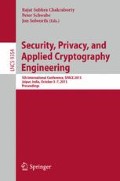Abstract
Physically unclonable functions (PUFs) provide data that can be used for cryptographic purposes: on the one hand randomness for the initialization of random-number generators; on the other hand individual fingerprints for unique identification of specific hardware components. However, today’s off-the-shelf personal computers advertise randomness and individual fingerprints only in the form of additional or dedicated hardware.
This paper introduces a new set of tools to investigate whether intrinsic PUFs can be found in PC components that are not advertised as containing PUFs. In particular, this paper investigates AMD64 CPU registers as potential PUF sources in the operating-system kernel, the bootloader, and the system BIOS; investigates the CPU cache in the early boot stages; and investigates shared memory on Nvidia GPUs. This investigation found non-random non-fingerprinting behavior in several components but revealed usable PUFs in Nvidia GPUs.
Access this chapter
Tax calculation will be finalised at checkout
Purchases are for personal use only
Preview
Unable to display preview. Download preview PDF.
References
AGMA Urges Manufacturers to Take Steps to Protect Products from Counterfeiters, http://businesswire.com/news/home/20071003005260/en/AGMA-Urges-Manufacturers-Steps-Protect-Products (October 2007)
AMD64 Architecture Programmer’s Manual Volume 2: System Programming. 3.23. AMD (May 2013)
BIOS and Kernel Developer’s Guide (BKDG) for AMD Family 14h Models00h-0Fh Processors. 3.13. AMD (February 2012)
van den Berg, R., Škorić, B., van der Leest, V.: Bias-based modeling and entropy analysis of PUFs. In: Armknecht, F., Seifert, J.-P. (eds.) Proceedings of Trust-Worthy Embedded Devices — TrustED 2013, pp. 13–20. ACM (2013)
Bohr, M.: 22nm SRAM announcement, http://download.intel.com/pressroom/kits/events/idffall_2009/pdfs/IDF_MBohr_Briefing.pdf (September 2009)
CUDA C Programming Guide: Design Guide. 7.0. Nvidia (March 2015)
Chauvet, J.-M., Mahe, E.: Secrets from the GPU. ArXiv e-prints (2013), See also: [17]. arXiv: 1305.3699
Di Pietro, R., Lombardi, F., Villani, A.: CUDA Leaks: Information Leakage in GPU Architectures. ArXiv e-prints (2013). arXiv: 1305.7383
GNU GRUB, https://www.gnu.org/software/grub/
Gassend, B., Clarke, D., van Dijk, M., Devadas, S.: Silicon physical random functions. In: Atluri, V. (ed.) Proceedings of Computer and Communications Security — CCS 2002, pp. 148–160. ACM (2002)
Guajardo, J., Kumar, S.S., Schrijen, G.-J., Tuyls, P.: FPGA Intrinsic PUFs and Their Use for IP Protection. In: Paillier, P., Verbauwhede, I. (eds.) Workshop on Cryptographic Hardware and Embedded Systems — CHES 2007. LNCS, vol. 4727, pp. 63–80. Springer, Heidelberg (2007)
Heninger, N., Durumeric, Z., Wustrow, E., Alex Halderman, J.: Mining Your Ps and Qs: Detection of Widespread Weak Keys in Network Devices. In: Proceedings of the 21st USENIX Security Symposium, p. 35. USENIX Association (2012)
King, R.: Fighting a Flood of Counterfeit Tech Products, http://www.bloomberg.com/bw/stories/2010-03-01/fighting-a-flood-of-counterfeit-tech-productsbusinessweek-business-news-stock-market-and-financial-advice (March 2010)
Lee, J.W., Lim, D., Gassend, B., Edward Suh, G., van Dijk, M., Devadas, S.: A technique to build a secret key in integrated circuits for identification and authentication applications. In: Symposium on VLSI Circuits 2004, pp. 176–179. IEEE (2004)
Lenstra, A.K., Hughes, J.P., Augier, M., Bos, J.W., Kleinjung, T., Wachter, C.: Public Keys. In: Safavi-Naini, R., Canetti, R. (eds.) Advances in Cryptology — CRYPTO 2012. LNCS, vol. 7417, pp. 626–642. Springer, Heidelberg (2012)
Maes, R., Tuyls, P., Verbauwhede, I.: Intrinsic PUFs from Flip-flops on Reconfigurable Devices. In: Workshop on Information and System Security — WISSec 2008 (2008)
Mahé, E., Chauvet, J.-M.: Secrets from the GPU. Journal of Computer Virology and Hacking Techniques 10(3), 205–210 (2014)
Owusu, E., Guajardo, J., McCune, J., Newsome, J., Perrig, A., Vasudevan, A.: OASIS: On Achieving a Sanctuary for Integrity and Secrecy on Untrusted Platforms. In: Proceedings of Computer and Communications Security — CCS 2013, pp. 13–24. ACM (2013)
Parallel Thread Execution ISA: Application Guide. 4.2. Nvidia (March 2015)
Schaller, A., Arul, T., van der Leest, V., Katzenbeisser, S.: Lightweight Anti-counterfeiting Solution for Low-End Commodity Hardware Using Inherent PUFs. In: Holz, T., Ioannidis, S. (eds.) Trust and Trustworthy Computing — TRUST 2014. LNCS, vol. 8564, pp. 83–100. Springer, Heidelberg (2014)
Schwabe, P.: Graphics Processing Units. In: Markantonakis, K., Mayes, K. (eds.) Secure Smart Embedded Devices: Platforms and Applications, pp. 179–200. Springer (2014)
Su, Y., Holleman, J., Otis, B.P.: A Digital 1.6 pJ/bit Chip Identification Circuit Using Process Variations. Journal of Solid-State Circuits 43(1), 69–77 (2008)
Suzuki, D., Shimizu, K.: The Glitch PUF: A New Delay-PUF Architecture Exploiting Glitch Shapes. In: Mangard, S., Standaert, F.-X. (eds.) Workshop on Cryptographic Hardware and Embedded Systems — CHES 2010. LNCS, vol. 6225, pp. 366–382. Springer, Heidelberg (2010)
Van Herrewege, A., van der Leest, V., Schaller, A., Katzenbeisser, S., Verbauwhede, I.: Secure PRNG Seeding on Commercial Off-the-shelf Microcontrollers. In: Armknecht, F., Seifert, J.-P. (eds.) Proceedings of Trustworthy Embedded Devices — TrustED 2013, pp. 55–64. ACM (2013)
Wong, H., Papadopoulou, M.-M., Sadooghi-Alvandi, M., Moshovos, A.: Demystifying GPU microarchitecture through microbenchmarking. In: Performance Analysis of Systems Software (ISPASS), pp. 235–246. IEEE (2010)
coreboot, http://www.coreboot.org/
Author information
Authors and Affiliations
Corresponding author
Editor information
Editors and Affiliations
Rights and permissions
Copyright information
© 2015 Springer International Publishing Switzerland
About this paper
Cite this paper
Van Aubel, P., Bernstein, D.J., Niederhagen, R. (2015). Investigating SRAM PUFs in large CPUs and GPUs. In: Chakraborty, R., Schwabe, P., Solworth, J. (eds) Security, Privacy, and Applied Cryptography Engineering. SPACE 2015. Lecture Notes in Computer Science(), vol 9354. Springer, Cham. https://doi.org/10.1007/978-3-319-24126-5_14
Download citation
DOI: https://doi.org/10.1007/978-3-319-24126-5_14
Published:
Publisher Name: Springer, Cham
Print ISBN: 978-3-319-24125-8
Online ISBN: 978-3-319-24126-5
eBook Packages: Computer ScienceComputer Science (R0)

